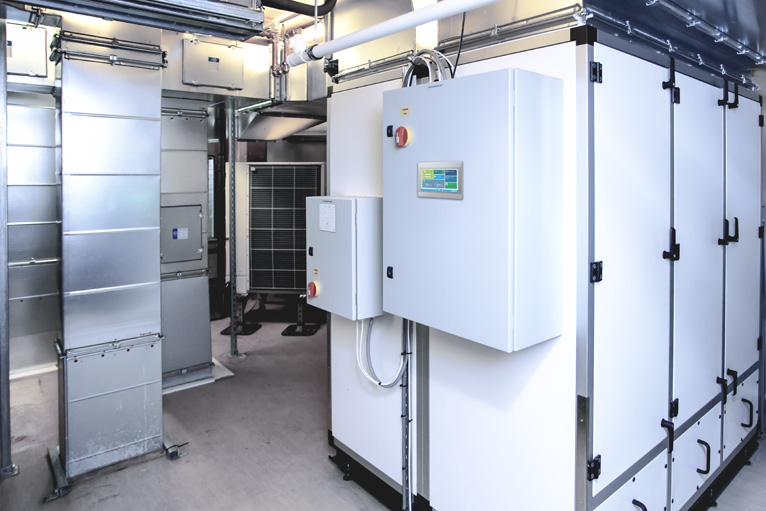Recirculating systems or ductless hoods have typically had limited capacity on the type of appliances they serve. In addition, the connected power of the appliance was limited by what the device was tested under to obtain its U.L. 710B certification. Similar to ducted exhaust hoods, when recirculating systems are tested, the results of those tests are part of the listing and must be installed in accordance with the listing.
A new breed of recirculating systems has come on the market in recent years that effectively decoupled from the appliances. Some devices have a more comprehensive range of appliances that can be used, but attention must be made to the maximum current draw. Others are self-contained mobile cooking platforms. The fan, filtration, fire systems are all self-contained within the unit.
In very general terms, these Recirculation units can be categorized as either; tower attached, remote tower, or mobile cooking station.

Tower Attached 
Remote Tower 
Mobile Cooking Station
The operation of these units is such that the exhaust air, drawn from above the cookline, is passed through several filtration processes, culminating in the air being sufficiently clean to be supplied safely, directly back into the space.
The central overriding premise with these systems is that they are only suitable for all-electric cooking….no gas-fired appliances….no solid-fuel-fired appliances.
Remote tower models provide the most significant degree of flexibility and capacity. The device is connected to a U.L. 710 listed hood using a conventional grease duct. The exhaust capacity of a remote tower is upwards of 3800 cfm. If used with a highly efficient exhaust hood, one can design a single hood or multiple hoods totaling 18 feet in length. A unique feature of this design is the ability to use virtually any electric appliance underneath the exhaust hood irrespective of connected power.
Remote Tower Reciculating Systems
Remote tower units have replaceable filters. The typical filtration process for these units is:
- F1 Large grease particulate removal. 50mm. G4 (EN779) Coarse (ISO16890)
- F2 Fine grease particulate removal. 100mm. M6 (EN779) 50-65% ePM2.5 to >60% ePM10
- F3 Particulate, Steam & Moisture removal. Rigid Bags. F9 (EN779) 85% ePM1 to 80% ePM1
- F4 Odour removal. Activated Carbon cylinders. Minimum dwell time of 0.2 seconds.

In order for these levels of filtration to operate at optimum performance, it is essential that the primary grease separators in the canopy (exhaust hood) or Ventilated Ceiling are of high quality and independently certified.
Some mobile units also deploy electrostatic precipitators (ESP) filtration in conjunction with media filters and carbon.
Benefits of Remote Tower Recirculating Systems.
- No requirement for any external supply & extract ductwork.
- Reduces the fire risk in the building.
- Tower can be located either internally or externally.
- Tower can, if required, be located horizontally, i.e. in a ceiling void.
- In certain applications added cooling may be required to offset the added heat load rejected to the space

The International Mechanical Code, 2018 states:
Factory-built commercial cooking recirculating systems that are listed and labeled in accordance with UL 710B, and installed in accordance with Section 304.1, shall not be required to comply with Sections 507.1.5, 507.2.3, 507.2.5, 507.2.8, 507.3.1, 507.3.3, 507.4, and 507.5. Spaces in which such systems are located shall be considered to be kitchens and shall be ventilated in accordance with Table 403.3.1.1. For the purpose of determining the floor area required to be ventilated, each individual appliance shall be considered as occupying not less than 100 square feet (9.3 m2).
Before selecting any recirculating systems, ensure you do your due diligence on requirements for installation based on the local authority having jurisdiction (AHJ). Some municipalities have specific needs or approvals beyond the products listing.
Should you require help in selecting a recirculating system, the experts that manufacture these types of units can guide you on the proper selection needed to meet your requirements.
Read another article relating to Recirculating or Ventless Solutions for Commercial Kitchen Ventilation – Advantages and Limitations of Ventless Solutions for Commercial Kitchen Ventilation
Subscribe today to kitchenventilation.com
Stay up to date by subscribing to Halton’s Commercial Kitchen Ventilation Blogs by entering your email address to subscribe and Halton will provide you with the latest information on commercial kitchen exhaust hoods, pollution control units, air handling, and safety systems. You will receive notifications of new posts by email.


Comments
2 responses to “New Approaches For Recirculating Systems in Kitchen Ventilation”
Dears, I believe that the size of grease particulate should be in “(µm)” not in “mm”
[…] Read another article relating to Recirculating or Ventless Solutions for Commercial Kitchen Ventilation – Advantages and Limitations of Ventless Solutions for Commercial Kitchen Ventilation or New Approaches For Recirculating Systems in Kitchen Ventilation […]